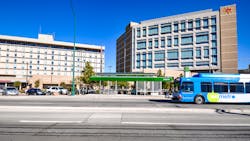When you plan to build a world-class transit system, at some point, things are bound to get a little dusty.
“Sometimes I think we’re a construction company more than a public transit system with as much construction as we’ve had in the past several years,” said Jay Banasiak, director of Sun Metro in El Paso, Texas.
After pulling itself away from the brink of crisis in 2005, the transit agency, with the support of the city of El Paso and the hiring of First Transit, began a long-term planning effort and eventual system build out that is ramping down as projects reach completion and services come online.
“Hopefully, I can start thinking about public transit again and not construction, which is a good thing,” said Banasiak.
The transit construction activities in El Paso the past several years include three bus routes for a rapid transit system (RTS) and planning for a fourth, a major transit-oriented development project and the re-establishment of streetcar service.
“We’re trying to give [riders] as many options as we can,” said Banasiak. “We've done pretty well in our operations and the construction is providing better amenities to El Paso and giving different options for [residents and visitors] to use.”
Providing accessible, attractive and viable travel options are key factors in assisting the economic development movement growing in El Paso now.
History of the build out
Sun Metro had a high profile opening of its streetcar line in late Fall of 2018, but as Banasiak explains, before the streetcar was even a glimmer, Sun Metro developed a plan for its $145-million Brio RTS, which is designed to reach all four corners of the El Paso area. The Mesa Brio opened in 2014 and connects the Downtown Transit Center to the Westside Transfer Center through 8.6 miles and 22 stations. Two more routes, the Alameda and Dyer will add a combined 24.7 miles to the RTS with a fourth route, Montana, the longest route, adding another 16.8 miles.
The Alameda Brio is scheduled to open in April 2019 with the Dyer Brio following in May. Banasiak says the Montana Brio design is finished and he anticipates going out to bid sometime this summer on the project.
The Mesa, Dyer and Montana routes are funded through the Federal Transit Administration Capital Investment Grant program and the Alameda route is funded 100 percent by the city of El Paso.
As Banasiak recalls, Sun Metro was well into the process of building and planning the Brio routes when Sun Metro caught wind of a rumor: The state of Texas was going to make funds available to build transit projects, a move it doesn’t usually make.
“We got on the stick and decided if we ever wanted to do a streetcar project, that we need to do some planning, get a specification made and, should money ever become available, we would have a kind of shovel ready project,” said Banasiak.
Once the specification for the streetcar project was written, it became a waiting game of when the state of Texas would take the plunge into transit funding. In 2014, the state issued $250 million in transportation funds with projects in Dallas, San Antonio, Houston and Austin receiving grants. Additionally, $97 million was awarded to the project that would return streetcar service to El Paso.
Camino Real Regional Mobility Authority was tasked with building the streetcar project, which began in November 2016 and turned the keys over to Sun Metro upon completion.
Streetcars had once been a familiar site in El Paso from the 1950s until 1974 when service ceased. Some of the streetcars were sold while others were stored in the desert, where the hot dry environment preserved their shells and trucks.
Banasiak shared that when Sun Metro was analyzing streetcar vehicle options, everything was considered from purchasing modern streetcars to purchasing replicas to refurbishing the vintage cars. A modern streetcar can run upwards of $5 million while refurbishing the existing cars was estimated to cost less than $3 million per car.
“The city council made the decision to go the refurbishing route, not only because it was less expensive, but also because it brought a bit of nostalgia to have these vintage streetcars back running service in downtown El Paso,” said Banasiak.
Brookville Corporation was awarded the contract to rebuild six Presidents’ Conference Committee (PCC) streetcars originally manufactured in 1937 for the 4.8-mile streetcar line after the original cars were, literally, dug out of the desert sand.
“One of the cool things about the refurbished cars is that if car 1511 ran back in 1970, we kept the same number. If someone rode car 1511 back in 1955, that same car, car 1511, is now running on the streets of El Paso,” Banasiak said.
While the streetcars boast a vintage look, they returned to service with many modern amenities. Banasiak explains that the interiors of the cars have been restored with new materials, but with a look that matches the interiors of the past. The streetcars also have better suspension systems, air conditioning, driver comfort features, more electrical elements to the trucks, modern fareboxes, which are used throughout Sun Metro’s system for seamless travel, WiFi on board, interior bike racks and ADA accessible features.
“We also have more analysis features of the streetcar, very similar to your car where you can analyze things a lot faster, a lot quicker,” Banasiak said. “With troubleshooting, we already have an idea of what the problem is before we even start digging into it.”
Following two years of construction, the streetcar line opened for service in November 2018. Banasiak explains the opening of the streetcar line brought extra relief to the residents of El Paso. They had to contend with the construction of the streetcar line and maintenance facility, as well as a large Texas Department of Transportation project all within the same area.
“There were a lot of improvements going on that people had to live through and not only do we have a great streetcar system now, but we don't have construction anymore,” said Banasiak. “It was like a double whammy of ‘thank goodness’.”
The start of streetcar service was well received with Banasiak reporting that the opening weekend saw streetcars constantly full of people. El Paso’s largest event, Winterfest, began shortly after the streetcar opening and the service helped move the thousands of attendees around downtown.
The third major project to come online in 2018 was the Northgate Transit Center, a $15.5-million transit-oriented development (TOD). The project was a recipient of a $13.2-million Transportation Investment Generating Economic Recovery (TIGER) grant in 2013. Sun Metro, partnering with Hunt Companies and the city of El Paso, redeveloped six acres that was part of an old mall into a transit center serving one of the fastest growing areas of El Paso. The transit center not only has bus space and a parking deck for 170 cars, but the TOD, known as Metro 31, is redeveloping the additional 24 acres into apartments, condos and retail space.
Training and outreach
With a massive system build out and many projects coming online at the same time, Sun Metro took steps to educate the public about safety around the new transit services.
Banasiak says Sun Metro’s efforts to get the word out about how to co-exist and be safe around streetcars were more than a year in the making and included several safety-focused videos, outreach to local businesses, their patrons, TV commercials and presentations at schools, associations and other community locations.
“I think the effort paid off. People are seeing the streetcar and they know a little bit about the safety of it, maybe they read it on a flier or saw it on TV or saw a presentation, but they know there are certain things that you have to be careful on with the streetcar,” Banasiak said. “Our marketing and staff have done a good job, along with our streetcar team, in getting the word out and addressing all the problems in a very quick manner.”
When it came to training operators, Banasiak says Sun Metro combined knowledge shared from peer agencies together with individuals who had streetcar experience.
“We visited several transit or streetcar agencies, but also we hired a couple people like Assistant Director of Streetcar Operations Carl Jackson and Mass Transit Department Chief Safety Officer Jose Marquez, who have had a lot of experience in building a streetcar system, running a streetcar and maintaining it. We put that all together,” said Banasiak. “We had a nice mixture on the management end of it. Then for the operator end of it and the maintenance end of it, most of the people came from our Sun Metro fixed route area.”
Sun Metro offered drivers, as well as maintenance personnel, an opportunity to train and transition to the streetcar system.
“We came up with a pretty aggressive safety training program. We took our time with them. We didn't rush them. They slowly got into it, they got trained into it and they became certified as operators for a streetcar,” explained Banasiak. “So far, so good. The people that really wanted to do it have become experts and they’ll continue to get better as they gain more experience.”
Measure of success
As Banasiak looks forward to construction wrapping up and returning his focus to public transit, he also has a vision of what he wants to see in Sun Metro’s future.
“People using the rapid transit system to get around town quickly, I think that is what success looks like,” Banasiak said. “Hopefully, they’ll use the Brio system and the streetcar system all as a seamless system. That’s exactly what the city council envisioned and that’s where we’re going. And then, in the next couple years after that, I would love to see the system continue to grow.”
Banasiak believes all good things begin with a plan. The plan to expand and build Sun Metro’s network had total stakeholder buy-in with backing from city council members, city residents and transit employees.
“We had a plan and not only were we able to accomplish that plan, but we were also able to build on that plan,” Banasiak said. “Stick to the plan and good things happen.”
About the Author

Mischa Wanek-Libman
Group Editorial Director
Mischa Wanek-Libman is director of communications with Transdev North America. She has more than 20 years of experience working in the transportation industry covering construction projects, engineering challenges, transit and rail operations and best practices.
Wanek-Libman has held top editorial positions at freight rail and public transportation business-to-business publications including as editor-in-chief and editorial director of Mass Transit from 2018-2024. She has been recognized for editorial excellence through her individual work, as well as for collaborative content.
She is an active member of the American Public Transportation Association's Marketing and Communications Committee and served 14 years as a Board Observer on the National Railroad Construction and Maintenance Association (NRC) Board of Directors.
She is a graduate of Drake University in Des Moines, Iowa, where she earned a Bachelor of Arts degree in Journalism and Mass Communication.
